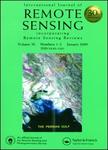版权所有:内蒙古大学图书馆 技术提供:维普资讯• 智图
内蒙古自治区呼和浩特市赛罕区大学西街235号 邮编: 010021

作者机构:Shandong Technol & Business Univ Sch Informat & Elect Engn Yantai Peoples R China Shandong Technol & Business Univ Sch Comp Sci & Technol Yantai 264005 Peoples R China Coinnovat Ctr Shandong Coll & Univ Future Intelligent Comp Yantai Peoples R China
出 版 物:《INTERNATIONAL JOURNAL OF REMOTE SENSING》 (国际遥感杂志)
年 卷 期:2022年第43卷第13期
页 面:4911-4950页
核心收录:
学科分类:083002[工学-环境工程] 0830[工学-环境科学与工程(可授工学、理学、农学学位)] 1002[医学-临床医学] 08[工学] 09[农学] 0804[工学-仪器科学与技术] 0903[农学-农业资源与环境] 0816[工学-测绘科学与技术] 081602[工学-摄影测量与遥感] 081102[工学-检测技术与自动化装置] 0811[工学-控制科学与工程]
基 金:National Natural Science Foundation of China [61772319, 62002200, 61972235, 12001327] Shandong Natural Science Foundation of China [ZR2021QF134, ZR2021MF068] Yantai science and technology innovation development plan [2022JCYJ031]
主 题:Pansharpening multispectral (MS) images panchromatic (PAN) images residual block encoder-decoder attention CRFB
摘 要:Pansharpening belongs to an important part in the field of remote sensing image fusion, which refers to the fusion of low spatial resolution multispectral (MS) images with high spatial resolution (PAN) images to finally obtain high resolution multispectral (HRMS) images. The existing deep learning-based pan-sharpening methods have achieved better results compared with the traditional methods, but there are still two problems: spectral distortion and loss of spatial detail information. We propose an end-to-end attention-based dual-residual multi-stage remote sensing image fusion network (ADRPN) for MS image and PAN image pan-sharpening based on an in-depth study of spectral information of MS images and spatial information fusion of PAN images, which consists of three main stages, each resembling an encoder-decoder, and cross-stage fusion to achieve channel domain feature stitching. The first two stages are the feature extraction stage, where the features of MS images and PAN images are extracted using the residual module, and the different features learned are used to guide the training of individual networks using CRFB (Cross residual feature block). In the third stage (image reconstruction), we use the CA (Coordinate attention) and SE (Squeeze-and-Excitation) attention mechanism to enable the network to more precisely locate the region of interest by the precise location information obtained, which allows the features extracted in the first two stages to be better fused with the original image, thus reducing the occurrence of spectral distortion and loss of spatial detail information. Qualitative and quantitative analyses of real and simulated data from the benchmark datasets QuickBird (QB), GF-2, and WorldView-2 (WV2) show that the method can better preserve the spectral and spatial detail information and obtain high-quality HRMS images.